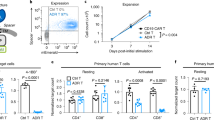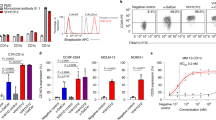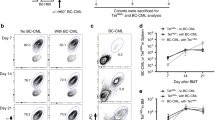Abstract
Selective elimination of alloreactive cells was carried out in the set-up of T-cell-mediated immunotherapy in an effort to gain the benefits of hematopoietic allogeneic transplantation while reducing the risk of GVHD. Low MW chemical compounds were screened for their effect on T-cell-mediated immune responses of murine- and human-derived lymphocytes. Selected compounds were further tested in secondary MLR assays in which sensitization to alloantigens was carried out in vitro, in the presence or absence of a given compound, followed by exposure to related and unrelated alloantigens or T-cell mitogenic stimulation. At a low concentration of <1 μM, a quinazoline derivative named AO#349 [2-(3,4,5-trimethoxyphenyl)-N-p-tolylquinazolin-4-amine], was able to induce 78–90% inhibition of a selective allogeneic response while retaining >92% immune reactivity to unrelated alloantigens and mitogenic stimuli in vitro. Following allogeneic sensitization in the presence of AO#349, elimination of alloreactivity to the priming alloantigens was also proved in a murine model of GVHD: 10 out of 15 sub-lethally irradiated mice inoculated with these sensitized cells were GVHD-free for >200 days. AO#349 was efficient in induction of a selective elimination of alloreactivity and should be considered for clinical application in allogeneic cell-mediated immunotherapy.
This is a preview of subscription content, access via your institution
Access options
Subscribe to this journal
Receive 12 print issues and online access
$259.00 per year
only $21.58 per issue
Buy this article
- Purchase on Springer Link
- Instant access to full article PDF
Prices may be subject to local taxes which are calculated during checkout






Similar content being viewed by others
References
Mitsuyasu RT, Champlin RE, Gale RP, Ho WG, Lenarsky C, Winston D et al. Treatment of donor bone marrow with monoclonal anti-T-cell antibody and complement for the prevention of graft-versus-host disease. A prospective, randomized, double-blind trial. Ann Intern Med 1986; 105: 20–26.
Devetten MP, Vose JM . Graft-versus-host disease: how to translate new insights into new therapeutic strategies. Biol Blood Marrow Transplant 2004; 10: 815–825.
Fowler DH . Shared biology of GVHD and GVT effects: potential methods of separation. Crit Rev Oncol Hematol 2006; 57: 225–244.
Shlomchik WD . Graft-versus-host disease. Nat Rev Immunol 2007; 7: 340–352.
Messina C, Faraci M, de Fazio V, Dini G, Calo MP, Calore E . Prevention and treatment of acute GvHD. Bone Marrow Transplant 2008; 41 (Suppl 2): S65–S70.
Chao NJ . Are there effective new strategies for the treatment of acute and chronic GvHD? Best Pract Res Clin Haematol 2008; 21: 93–98.
Panigrahi S, Morecki S, Yacovlev E, Gelfand Y, Kassir J, Slavin S . A novel approach for prevention of lethal GVHD by selective elimination of alloreactive donor lymphocytes prior to stem cell transplantation. Exp Hematol 2004; 32: 756–764.
Prigozhina TB, Elkin G, Khitrin S, Slavin S . Depletion of donor-reactive cells as a new concept for improvement of mismatched bone marrow engraftment using reduced-intensity conditioning. Exp Hematol 2004; 32: 1110–1117.
Prigozhina TB, Elkin G, Khitrin S, Slavin S . Prevention of acute graft-vs-host disease by a single low-dose cyclophosphamide injection following allogeneic bone marrow transplantation. Exp Hematol 2008; 36: 1750–1759.
Morecki S, Slavin S, Ben-Sasson SA . Selective abrogation of alloreactivity via priming in the presence of aphidicolin, a specific inhibitor of DNA polymerase. J Immunol 1989; 143: 838–843.
Godfrey WR, Krampf MR, Taylor PA, Blazar BR . Ex vivo depletion of alloreactive cells based on CFSE dye dilution, activation antigen selection, and dendritic cell stimulation. Blood 2004; 103: 1158–1165.
Mielke S, Solomon SR, Barrett AJ . Selective depletion strategies in allogeneic stem cell transplantation. Cytotherapy 2005; 7: 109–115.
Aviner S, Yao X, Krauthgamer R, Gan Y, Goren-Arbel R, Klein T et al. Large-scale preparation of human anti-third-party veto cytotoxic T lymphocytes depleted of graft-versus-host reactivity: a new source for graft facilitating cells in bone marrow transplantation. Hum Immunol 2005; 66: 644–652.
Barrett AJ, Le Blanc K . Prophylaxis of acute GVHD: manipulate the graft or the environment? Best Pract Res Clin Haematol 2008; 21: 165–176.
Chen BJ, Cui X, Liu C, Chao NJ . Prevention of graft-versus-host disease while preserving graft-versus-leukemia effect after selective depletion of host-reactive T cells by photodynamic cell purging process. Blood 2002; 99: 3083–3088.
Boumedine RS, Roy DC . Elimination of alloreactive T cells using photodynamic therapy. Cytotherapy 2005; 7: 134–143.
Harris DT, Sakiestewa D, Lyons C, Kreitman RJ, Pastan I . Prevention of graft-versus-host disease (GVHD) by elimination of recipient-reactive donor T cells with recombinant toxins that target the interleukin 2 (IL-2) receptor. Bone Marrow Transplant 1999; 23: 137–144.
André-Schmutz I, Le Deist F, Hacein-Bey-Abina S, Vitetta E, Schindler J, Chedeville G et al. Immune reconstitution without graft-versus-host disease after haemopoietic stem-cell transplantation: a phase 1/2 study. Lancet 2002; 360: 130–137.
Amrolia PJ, Muccioli-Casadei G, Yvon E, Huls H, Sili U, Wieder ED et al. Selective depletion of donor alloreactive T cells without loss of antiviral or antileukemic responses. Blood 2003; 102: 2292–2299.
Fehse B, Frerk O, Goldmann M, Bulduk M, Zander AR . Efficient depletion of alloreactive donor T lymphocytes based on expression of two activation-induced antigens (CD25 and CD69). Br J Haematol 2000; 109: 644–651.
Koh MB, Prentice HG, Lowdell MW . Selective removal of alloreactive cells from haematopoietic stem cell grafts: graft engineering for GVHD prophylaxis. Bone Marrow Transplant 1999; 23: 1071–1079.
Prigozhina TB, Gurevitch O, Elkin G, Morecki S, Yakovlev E, Slavin S . CD40 ligand-specific antibodies synergize with cyclophosphamide to promote long-term transplantation tolerance across MHC barriers but inhibit graft-vs-leukemia effects of transplanted cells. Exp Hematol 2003; 31: 81–88.
Ge X, Brown J, Sykes M, Boussiotis VA . CD134-allodepletion allows selective elimination of alloreactive human T cells without loss of virus-specific and leukemia-specific effectors. Biol Blood Marrow Transplant 2008; 14: 518–530.
Wehler TC, Nonn M, Brandt B, Britten CM, Gröne M, Todorova M et al. Targeting the activation-induced antigen CD137 can selectively deplete alloreactive T cells from antileukemic and antitumor donor T-cell lines. Blood 2007; 109: 365–373.
Hartwig UF, Robbers M, Wickenhauser C, Huber C . Murine acute graft-versus-host disease can be prevented by depletion of alloreactive T lymphocytes using activation-induced cell death. Blood 2002; 99: 3041–3049.
Hartwig UF, Nonn M, Khan S, Link I, Huber C, Herr W . Depletion of alloreactive donor T lymphocytes by CD95-mediated activation-induced cell death retains antileukemic, antiviral, and immunoregulatory T cell immunity. Biol Blood Marrow Transplant 2008; 14: 99–109.
Morecki S, Gelfand Y, Yacovlev E, Eizik O, Shabat Y, Slavin S . CpG-induced myeloid CD11b+Gr-1+ cells efficiently suppress T cell-mediated immunoreactivity and graft-versus-host disease in a murine model of allogeneic cell therapy. Biol Blood Marrow Transplant 2008; 14: 973–984.
Morecki S, Panigrahi S, Pizov G, Yacovlev E, Gelfand Y, Eizik O et al. Effect of KRN7000 on induced graft-vs-host disease. Exp Hematol 2004; 32: 630–637.
Morecki S, Yacovlev E, Gelfand Y, Uzi I, Slavin S . Cell therapy with preimmunized effector cells mismatched for minor histocompatible antigens in the treatment of a murine mammary carcinoma. J Immunother 2001; 24: 114–121.
Kaplan E . Non-parametric estimation from incomplete observation. Am Stat 1958; 53: 457–481.
Mantel N . Evaluation of survival data and two new rank order statistics arising in its consideration. Cancer Chemother Rep 1966; 50: 163–170.
Gazit A, Yaish P, Gilon C, Levitzki A . Tyrphostins I: synthesis and biological activity of protein tyrosine kinase inhibitors. J Med Chem 1989; 32: 2344–2352.
Säemann MD, Böhmig GA, Osterreicher CH, Staffler G, Diakos C, Krieger PM et al. Suppression of primary T-cell responses and induction of alloantigen-specific hyporesponsiveness in vitro by the janus kinase inhibitor tyrphostin AG490. Transplantation 2000; 70: 1215–1225.
Baeuerle PA, Baichwal VR . NF-kappa B as a frequent target for immunosuppressive and anti-inflammatory molecules. Adv Immunol 1997; 65: 111–137.
Ghosh S, May MJ, Kopp EB . NF-kappa B and Rel proteins: evolutionarily conserved mediators of immune responses. Annu Rev Immunol 1998; 16: 225–260.
Karin M, Ben-Neriah Y . Phosphorylation meets ubiquitination: the control of NF-[kappa]B activity. Annu Rev Immunol 2000; 18: 621–663.
Sun K, Welniak LA, Panoskaltsis-Mortari A, O’Shaughnessy MJ, Liu H, Barao I et al. Inhibition of acute graft-versus-host disease with retention of graft-versus-tumor effects by the proteasome inhibitor bortezomib. Proc Natl Acad Sci USA 2004; 101: 8120–8125.
Vodanovic-Jankovic S, Hari P, Jacobs P, Komorowski R, Drobyski WR . NF-kappaB as a target for the prevention of graft-versus-host disease: comparative efficacy of bortezomib and PS-1145. Blood 2006; 107: 827–834.
Zhou R, Zhang F, He PL, Zhou WL, Wu QL, Xu JY et al. (5R)-5-hydroxytriptolide (LLDT-8), a novel triptolide analog mediates immunosuppressive effects in vitro and in vivo. Int Immunopharmacol 2005; 5: 1895–1903.
Fu YF, Zhu YN, Ni J, Zhong XG, Tang W, Zhou R et al. (5R)-5-hydroxytriptolide (LLDT-8), a novel triptolide derivative, prevents experimental autoimmune encephalomyelitis via inhibiting T cell activation. J Neuroimmunol 2006; 175: 142–151.
Tang W, Zhou R, Yang Y, Li YC, Yang YF, Zuo JP . Suppression of (5R)-5-hydroxytriptolide (LLDT-8) on allograft rejection in full MHC-mismatched mouse cardiac transplantation. Transplantation 2006; 81: 927–933.
Tang W, Yang Y, Zhang F, Li YC, Zhou R, Wang JX et al. Prevention of graft-versus-host disease by a novel immunosuppressant, (5R)-5-hydroxytriptolide (LLDT-8), through expansion of regulatory T cells. Int Immunopharmacol 2005; 5: 1904–1913.
Saiga K, Toyoda E, Tokunaka K, Masuda A, Matsumoto S, Mashiba H et al. NK026680, a novel compound suppressive of dendritic cell function, ameliorates mortality in acute lethal graft-versus-host reaction in mice. Bone Marrow Transplant 2006; 37: 317–323.
Cetkovic-Cvrlje M, Roers BA, Waurzyniak B, Liu XP, Uckun FM . Targeting Janus kinase 3 to attenuate the severity of acute graft-versus-host disease across the major histocompatibility barrier in mice. Blood 2001; 98: 1607–1613.
Sagiv-Barfi I, Weiss E, Levitzki A . Design, synthesis, and evaluation of quinazoline T cell proliferation inhibitors. Bioorg Med Chem 2010; 18: 6404–6413.
Prigozhina TB, Gurevitch O, Morecki S, Yakovlev E, Elkin G, Slavin S . Nonmyeloablative allogeneic bone marrow transplantation as immunotherapy for hematologic malignancies and metastatic solid tumors in preclinical models. Exp Hematol 2002; 30: 89–96.
Acknowledgements
The authors wish to thank Kirin Brewery Co. Ltd, Tokyo, Japan for its generous support of our research.
Author information
Authors and Affiliations
Corresponding author
Ethics declarations
Competing interests
The authors declare no conflict of interest.
Rights and permissions
About this article
Cite this article
Morecki, S., Gelfand, Y., Yacovlev, E. et al. Selective elimination of alloreactivity in vitro and in vivo while sparing other T-cell-mediated immune responses. Bone Marrow Transplant 47, 838–845 (2012). https://doi.org/10.1038/bmt.2011.198
Received:
Revised:
Accepted:
Published:
Issue Date:
DOI: https://doi.org/10.1038/bmt.2011.198
Keywords
This article is cited by
-
Apoptotic signaling through Fas and TNF receptors ameliorates GVHD in mobilized peripheral blood grafts
Bone Marrow Transplantation (2014)



